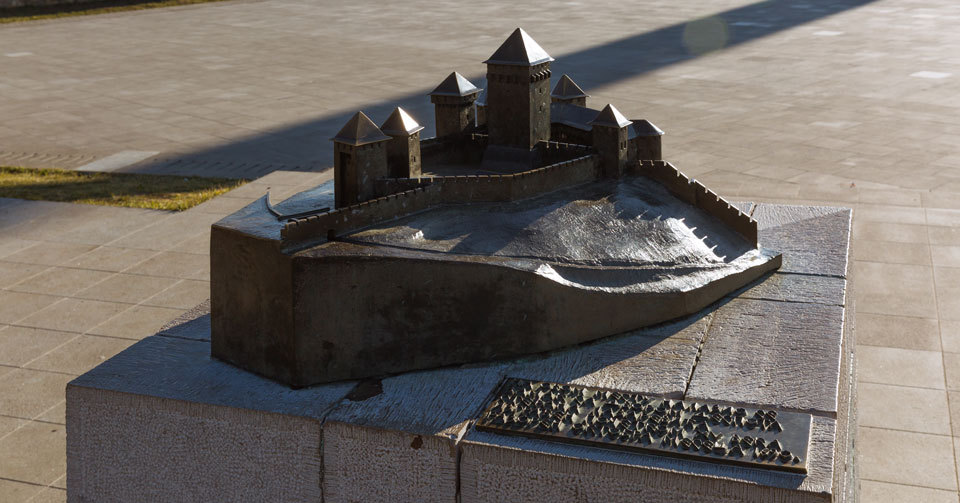
By the end of the 12th century Stefan Nemanja was an ally to the Hungarian king Bela III in his struggle against Byzantium. Unsatisfied with the selection of his younger brother Stefan the First-Crowned to be the successor, the eldest son of Nemanja Vukan picked up arms and sought support of the Hungarian king. In 1202 the Hungarian troops entered Serbia and forced Stefan to retreat. Belgrade fell into the Hungarian hands. On the other hand, Stefan sought help from the Bulgarian king Kaloyan who didn’t want to see Hungarian influence spread in the Balkans. Already next year the Bulgarians launched an offensive and with their help Stefan the First-Crowned managed to restore his rule over the country.
The history of Belgrade in the 13th century wasn’t precisely recorded. It’s known that in 1204 the city was under Hungarian rule and then every record is lost until 1230 when, according historical sources it belonged to Bulgarian state. Already two years later it came back under the power of the Hungarian king and in terms of religious jurisdiction it came under the authority of the Sirmium episcope. Its history from then on was linked to Hungary while for Bulgarians it was lost forever.
The age when the Congregation church was built
Belgrade first came under Serbian rule in 1284 and it happened peacefully. King Dragutin was married to the Hungarian princess Katarina, daughter of king Stefan, who had pro-Hungarian policies from the start. Two years after he gave up the Serbian throne in favor of his brother Milutin, he was given authority over Macva with Belgrade from the Hungarian crown.
Dragutin ruled over this area for 30 years and greatly helped spread Serbian population and Orthodox Christianity throughout it. This was where his court was located and the newly constructed Congregation church was a symbol of strength of the Serbian Orthodox church. However, until the very end of his life Dragutin remained loyal to the Hungarian king, so that area was also dependent on Hungary.
After Dragutin’s death in 1316 king Milutin conquered Belgrade and the entire area ruled by Dragutin previously. Throughout the following three years, Belgrade was under Serbian rule and then king Karlo Robert began to restore the lost territories. The Hungarian military led by Stefan Lackogic conquered and burned down Belgrade 1319, when it was entrusted to the Bane of Macva.
In the following decades, Belgrade was an important border stronghold for Hungarian forces during their struggles against the growing Serbian empire. After the death of Emperor Dusan, Belgrade still maintained its important strategic role for the Hungarian breaching into Serbia.
The Horvat brothers uprising
Up until the death of king Louis I of Hungary in 1382, Belgrade remained under Hungarian control. Seeing how the Hungarian king didn’t have any male heirs, the throne was taken over by queen Elizabeth of Bosnia in the name of her daughter Maria. In Hungary there was internal unrest. A group of nobles, mostly from Croatia, attempted to bring an Angevin dynasty from Naples to the throne and this uprising quickly spread out to Macva and Belgrade.
The Horvat brothers managed to conquer Belgrade and fortify this area. According to some sources, knez Lazar’s army also participated in the siege of Belgrade at the time. The uprising was snuffed out around four years later and ruling over Belgrade was left under the former Bane of Macva, Stevan of Korodj and returned to the Hungarian crown.
It was in those circumstances that Belgrade greeted the start of the 15th century and the appearance of a new conquering force – the Ottoman empire.
Serbian capital for the first time
After their defeat in the Battle at Ankara and the death of Bayezid I, the Ottoman empire was experiencing an internal crisis due to the resulting power struggle. In those circumstances, the despot Stefan Lazarevic grew closer to Hungary. Based on an agreement he signed with the Hungarian king Sigismund of Luxemburg, Despot Stefan becomes the ruler of Belgrade in 1403.
During his 20 years long reign, Belgrade experienced a surge of growth and progress and for the first time became the capital of the Serbian state.
Despot Stefan built the city up from ashes and rubble and made it into a glowing capital. He constructed new fortifications, the court for himself, churches, a library and hospital. Belgrade of that time was much more than a military fortification, it was also the trade, culture and religion center of the entire region. The various privileges and tax exemptions that Despot Stefan introduced in Belgrade attracted traders from all around the Balkans, especially Dubrovnik. They would bring mining products most of all, especially silverware, but also fabrics and many other crafted goods.
Belgrade of that time was also the seat of Belgrade’s mitropolit Isidor. It was around this time that the mitropolit church of “heavenly Vladicica’s rising” was constructed and very lavishly equipped. It was where they kept the famous St. Mary icon. In addition to this one, there were numerous other churches both Orthodox and Catholic. This was also when church Ruzica was built.
The death of Despot Stefan abruptly ended the rapid development of Belgrade and completely turned around the situation. According to a previously signed agreement, Stefan’s successor Djuradj Brankovic had to surrender Belgrade to Hungary in 1427. This meant once again massive changes for the authorities, church and ethnic situation of the city. King Sigimund inhabits Belgrade with Hungarian populace and spreads the influence of Catholic church.
Turkish invasion and the fall of Belgrade
After conquering Serbian territories, Turkey breached all the way to the walls of Belgrade in 1440. Sultan Murat II led his massive army in a huge assault on the city, but after several months of siege he was forced to retire.
After the fall of Constantinople the Christian Europe was dreading the Turkish advances. It was clear to all that Sultan Mehmed II will soon launch an offensive against Hungary. However, the attempts to organize a commonplace army of Christians to oppose the Turks were not successful. What’s more, there wasn’t even enough unity within the Hungarian army itself, as they were consumed by panic. Many nobles – led by their king – were fleeing their lands and running west. When in 1456 Turkish forces appeared at the ramparts of Belgrade, Mihailo Siladji and John Hunyadi were leading the defenders – both of them seasoned heroes when it came to combating Turks.
After a long and bloodied struggle and massive losses in troops as well as his own wounding, Mehmed II decided to retreat. Once again, Belgrade withstood the offensive. As ordered by Pope Callixtus III the afternoon church bells celebrated this event until present day.
After the long siege of Belgrade, Hungary – torn apart from within due to conflicting interests of its many nobles – inched towards the abyss bit by bit.
Unlike older times when Hungary had a capable defender like John Hunyadi, at the start of the 16th century there was no strong leader to oppose the Turks. When in 1520 he took over the throne, Sultan Suleiman the Magnificent set his sight to conquer Belgrade and succeed where his ancestors had failed. Already in the next year, he managed to achieve his goal.
Taught by the mistakes of his predecessors, Suleiman first conquered Srem and then assaulted Belgrade from multiple sides. Though the defenders fought bravely, they didn’t stand a chance against a superior force that launched a patient, sustained assault. Belgrade finally came under Turkish control on 28th of August 1521, thus ending an entire era in history.




 2 ℃
2 ℃



